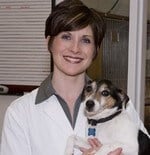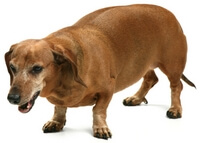How to Help Your Overweight Dog Lose Weight
DogFoodAdvisor is reader supported See how
Dog Food Advisor is 100% impartial and is never paid to promote any brand. But if you buy using links on this page, we may earn a referral fee.
Want to know a simple secret that can help your overweight dog lose weight? And live longer, too?

To be successful, every weight loss plan must be based upon one simple principle…
Dogs that consume fewer calories than they burn lose weight
Simple, right? Yet if weight loss was truly that easy, why are so many pets overweight?
An Epidemic of Overweight Dogs
Today, dogs are fatter than ever. It’s now estimated that 45% of all U.S. dogs are either overweight or obese.1
That’s 35 million dogs.
What’s worse, obesity can be life-threatening, too. An overweight dog is more likely to suffer from a disabling medical condition like…
- Diabetes
- Arthritis
- Heart disease
- Lung disorders
- High blood pressure
- Immune dysfunction
- Cancerous tumors
Add Two Extra Years
to Your Dog’s Life
A recent study proves that dogs maintaining ideal body weight live almost two years longer (and with significantly less disease) than their overweight siblings.2
An overweight dog is more likely to die at a younger age
In other words, you can add nearly two extra years to your dog’s life just by maintaining your pet’s ideal weight.
A Couch Potato Eating Machine
Unfortunately, many fail to recognize a fat dog.
Veterinarians report that although nearly 50% of all the dogs they see are overweight, only 17% of pet owners agree.
It can sometimes be difficult for an owner to admit her 80 pound dog is 20 pounds overweight — not just “big-boned”.
Every day I hear pet owners comment, “How can he be overweight? He hardly eats anything”.
Obesity is frequently indicative that our dogs are sedentary, couch potato eating machines burning almost no calories.
The Solution
The obesity equation is actually very simple. Dogs that consume more calories than they burn gain weight.
So, to lose weight…
Your dog must eat less — and exercise more
That’s all there is to successful weight loss. Best of all, if you work out together, exercise can be great for you, too.
The Goal
Your Dog’s Ideal Weight
Start your plan by knowing your dog’s ideal weight. Not only can your veterinarian help you do this, but she can also screen your pet for certain conditions that can contribute to obesity…
- Diabetes
- Cushing’s Disease
- Hypothyroidism
You can also visit the Association for Pet Obesity Prevention for some suggested weight ranges for specific breeds.
How to Calculate Calories
for Weight Loss
Once you know your dog’s ideal weight, you’ll be able to discover the amount of calories to feed your dog daily to achieve steady weight loss.
Use the Advisor’s dog food calculator to determine this important number.
While most dogs will experience predictable weight loss when fed this amount each day, others may require even fewer calories. This can depend on a dog’s age and activity level.
The Problem with a Dog Food Label
Label recommendations are designed for weight maintenance… not weight loss. Following these instructions will likely lead to continued gains.
To control weight, you must know how many calories are in a cup of food. Then, feed according to calories.
Also, if your dog is severely overweight, your vet may need to help you design a custom weight loss program for your pet.
The Wrong Way to Feed a Dog
Many dogs are fed free choice — which means food is available 24 hours a day. So, the dog eats whenever it wants.
Free choice feeding is completely unnatural for any mammal. And (just like us humans), a dog will eat when bored — instead of just when hungry.
What’s more, free feeding can contribute to unnatural hormonal changes — which can make weight loss even more challenging.
And the Right Way
A dog should be fed two to four small portions a day. And the total number of calories for all meals and treats must equal the number of calories desired for weight loss.
If your schedule makes it difficult to follow this strategy, there are timed automatic feeders that can help your pet get the right amount of food.
And only at specific times.
Don’t Guess — Measure
It’s critical to actually measure your dog’s food. Never guess. Use an 8 ounce measuring cup… not a coffee cup or a food scoop.
Then be sure to dispense the exact amount of food called for in your calculations.
The Trouble with Most
Weight Loss Foods
Although there are many foods marketed for canine weight loss, not all are created equal. Products described as “diet”, “lite” or “reduced-calorie” may not be the best choice.
Many of these recipes replace meat content with high levels of carbohydrate fillers. This creates a low-calorie, bulky food that helps your dog feel full.
But only for a short time. Some aren’t very tasty and most tend to cause an increase in stool production.
These products can lead to dogs who are constantly hungry. Many times pets even gain weight due to the difficulty of staying on track in the face of persistent begging.
Most regular maintenance diets are high in calories (usually between 450 and 550 calories per cup or per can) making it easy to overfeed your pet.
Less Food — More Begging
While weight loss can sometimes be achieved by feeding less of your dog’s regular maintenance food, you’ll find you must feed very small amounts to achieve the reduced number of calories required to lose weight.
This leads to a pet that may feel less satisfied and begs more.
What to Look for
in an Ideal Weight Loss Product
For successful weight loss, choose a quality dog food with…
A higher protein content helps a dog feel more satisfied with less begging. This makes it easier for you to stick to the diet.
These products also help combat muscle loss… an unwelcome side effect with dieting.6
Lower calories allows your dog to eat more and still lose weight.
Weight loss is often easier to achieve by adding canned food to your dog’s feeding regimen.
Canned products usually have higher protein, lower carbohydrates and fewer calories compared to a similar sized quantity of kibble.
It’s also possible to achieve a good high protein weight loss diet by combining a high quality commercial dog food with low-calorie home-cooked foods. This should be accomplished with the help of your veterinarian or veterinary nutritionist.
Exercise. Exercise. Exercise.
Forty percent of American adults do not participate in any leisure time physical activity. So, no doubt our dogs are just as sedentary.
In humans, physical activity has been proven to
- Aid in weight loss
- Lessen heart disease
- Lower cholesterol levels
- Decrease the risk of diabetes
- Control anxiety and depression
- Reduce the risk of certain cancers
- Slow bone loss associated with advancing age
We can probably expect many of these same benefits for our pets.
So, get your dog moving. Take a walk. Run. Play fetch. Swim. Climb the stairs. Provide at least 30 minutes of brisk exercise every day to facilitate weight loss.
How to Monitor Your Dog’s Weight Loss
Monitor your dog’s progress. Weigh your dog at least every 1 to 2 weeks. Using the recommended guidelines, overweight or obese dogs should lose about 1% to 2% of their body weight each week.
If your dog is not losing weight, the daily calories may need to be restricted further.
Also make sure no one in the house is cheating by giving extra food or treats.
Once You Reach Your Goal
Once the ideal weight is reached, the amount of food your dog is eating will likely need to be increased.
It’s important to continue weighing and monitoring your dog for any future change in weight.
So, keep a log. And make any necessary adjustments throughout your dog’s life to maintain an ideal weight.
My Recommended Dog Foods
for Weight Loss
To see a list of my current recommendations, be sure to visit the Advisor’s article, “Dog Foods for Weight Loss“.
Donna Spector, DVM, DACVIM is a renowned, board-certified Veterinary Internal Medicine Specialist.

Dr. Spector has written and lectured extensively on topics including animal nutrition, diabetes, gastrointestinal disorders, and kidney failure. She is widely acknowledged for her role as consulting veterinarian to Halo, Purely for Pets and her TV appearances with The Ellen DeGeneres Show.
Dr. Spector’s online consulting service offers personalized and tailored medical, nutritional and weight loss consultations for owners of both dogs and cats.
She provides professional advice relating to urinary disorders, liver problems, immune diseases, intestinal issues, diabetes, asthma and other breathing conditions, hormonal problems and other internal medical complaints.
Final word
The Dog Food Advisor does not accept money, gifts, samples or other incentives in exchange for special consideration in preparing our reviews.
However, we do receive a referral fee from online retailers (like Chewy or Amazon) and from sellers of perishable pet food when readers click over to their websites from ours. This helps cover the cost of operation of our free blog. Thanks for your support.
For more information, please visit our Disclaimer and Disclosure page.




